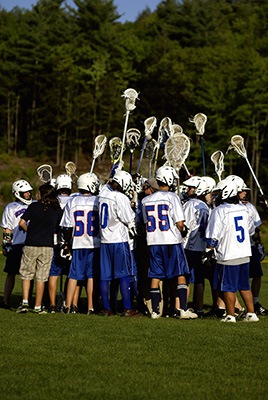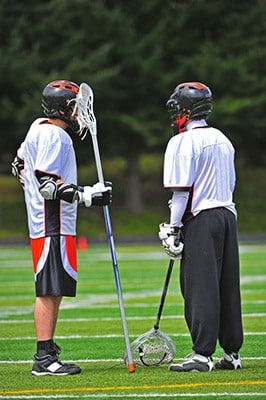Lacrosse is an exhilarating and dynamic sport. With the combination of fast-paced action, acute ball-handling skills, and strategic team formations - lacrosse is undeniably a thrilling game to play. Therefore, knowing how to best utilize strategy and tactics in your lacrosse formation can be critical for success.
For this reason, it's necessary to hone your knowledge of tactical schemes that will allow you to gain maximum advantage over your opponents. If you're curious about understanding the fundamentals of effective lacrosse formation to up level as an athlete - read on!
Below is an overview guide into the tactical schemes of lacrosse formation that every player should know by 2023!
More...
Take Away Key Points:
What is an offensive formation?

Lacrosse is a team sport involving two players using sticks to pass and catch a ball to score goals. Offensive formations are how players are arranged on the field when attacking or defending.
An offensive play in lacrosse is led by the attackmen, with support from the midfielders. The defensive players rely on the defensemen with assistance from the midfielders.
Teams dedicate countless hours to training their players in lacrosse attack drills to ensure a successful offensive strategy. This allows every individual to comprehend their position and how it ties into the formation of a cohesive unit, resulting in the proficient execution of strategic plays.
The most common offensive formations are the 1-4-1, which consists of one attackman behind the goal, four midfielders across the field, and one attackman at the top of the arc. This formation is ideal for teams with solid dodgers who can use their speed and agility to create scoring.
Basic lacrosse offensive play formations
2-3-1 formation
This 2-3-1 formation involves two attackmen, three midfielders, and one defender. It is a balanced formation that allows for quick passing and ball movement.
The 2-3-1 formation is designed to create a balanced offensive set attack with multiple options for ball movement. The formation can also be positioned in two attackmen and one middie.
Pros
One of the main advantages of the 2-3-1 formation is that it allows for quick ball movement between players in different field areas. This can be beneficial when trying to move the ball upfield quickly, as well as creating scoring opportunities.
Additionally, it provides a good balance between attacking and defending players, allowing for more defensive support if needed.
Cons
However, there are some drawbacks to using this formation. For example, it can be difficult to maintain possession if too many passes are made without any real purpose or direction. Additionally, getting all players involved in the offense can be difficult if they are spread out too far apart.
Overall, the 2-3-1 lacrosse formation is a great way to create a balanced offensive set attack while still providing plenty of options for ball movement and scoring chances.
In addition, it can be used effectively in both transition and settled situations, depending on how it's implemented by coaches and players alike.
2-2-2 formation
This formation is similar to the 2-3-1 but with two defenders instead of one. It is often used when teams want to focus on defense rather than offensive players.
The 2-2-2 lacrosse formation is a widespread offensive set strategy that creates balanced spacing and puts equal pressure on the defense.
The attackmen are positioned at the top of the field near the goal, while the two midfielders are spread across the center of the field. The defensemen are positioned near their goal at the bottom of the field.
Pros
The main advantage of this formation is that it allows for more efficient ball movement and better scoring. It also creates space for players to make cuts and dodge defenders.
Additionally, it gives players more time to set up plays and make decisions before they have to shoot or pass.
Cons
On the other hand, one of its drawbacks is that it can be difficult to maintain possession if your opponents can disrupt your passing lanes or double-team your players. Additionally, it can be challenging to transition from two offensive players to defense quickly when using this formation since there are only two defenders in position to stop a fast break.
Overall, the 2-2-2 lacrosse formation is an excellent option for teams looking to score more and move the ball efficiently around the field.
3-1-2 Formation

The 3-1-2 lacrosse formation is a popular offensive formation that consists of three midfielders across the top of the box, one attackman on the crease, and two attackmen behind the goal line extended (GLE).
Pros
This formation allows for good spacing for the three attackmen and creates opportunities for dodging to unbalance the defense. It also provides multiple passing options and can be used to develop fast-paced transition play.
Cons
However, this formation requires players to have strong stick skills and good communication to be successful. The midfielders must be able to move quickly up and down the field while still maintaining their positions. Additionally, all players must know their surroundings to decide when to pass or shoot.
Overall, the 3-1-2 lacrosse formation is an excellent option for teams looking to create fast-paced lacrosse offenses with many passing options. With proper execution, it can help teams score goals quickly and efficiently.
Invert formation
The inverted formation reverses the typical setup by running plays with midfielders below the goal line extended area instead of above it. It can be used to create mismatches and confuse opponents' defenses.
The primary purpose of this formation is to create more space for attackmen and allow them to have more time and space with the ball. This formation can create mismatches, open up passing lanes, and create scoring.
Pros
One of the main advantages of using the invert lacrosse formation is that it allows many teams to spread their offense and makes it harder for defenders to double team or slide quickly. It also will enable attackmen to get into better shooting positions as they are not stuck behind a wall of defenders. Additionally, this formation can help create more passing opportunities as there are more players in position to receive passes.
Cons
However, there are some drawbacks associated with using the invert lacrosse formation. For example, it can be difficult for many teams to transition from defense to offense quickly when using this formation, as they must move all their players back into position before attacking.
Additionally, if an attackman does not have good ball control or decision-making skills, then he may struggle in this formation as he will have less time and space with the ball than he would in other formations.
Overall, the Invert lacrosse formation can be a great way for teams to create scoring chances and open up passing lanes while also making it harder for defenders to double team or slide quickly.
Man-to-man defense
Man-to-man defenses are one of the most common formations used in lacrosse. This formation involves each defender guarding an offensive player and staying with them at all times. The goal is to limit scoring by preventing the offensive player from having space and time on the ball.
Pros
The pros of man-to-man defense include that it allows for fast transitions from defense to offense, as defenders can quickly move upfield if they have successfully pressured their player.
Cons
The cons of man-to-man defense include that it can be vulnerable to fast breaks or mismatches in size.
Additionally, defenders may become fatigued if they need to hustle back quickly after pressing forward on a fast break or after an unsuccessful challenge.
Motion offense
Motion offense involves constant movement from all players on the field in order to maintain balance and create opportunities for scoring chances.
The Motion offense lacrosse formation is an offensive strategy that relies on the movement of all seven players. It involves two triangles, with three players in each triangle, and the ball moving around the wheel and being passed within three seconds. This formation creates movement and balances both off-the-dodge and off-ball, allowing for quick passes and shots on goal.
Pros
The pros of this formation are that it allows for quick passing, creating opportunities to score goals quickly. Additionally, it keeps defenders on their toes as they must constantly adjust to the offense's motion. Finally, it helps create space for cutters to move into open field areas.
Cons
The cons of this formation are that it can be challenging to execute if players are not familiar with it or do not have good communication skills. Additionally, if a player dodges without looking for a pass first, then there may be no one available to receive the ball quickly and take a good shot on goal. Finally, if defenders can anticipate where cutters will go, then they can shut down passing lanes and disrupt the flow of play.
Box offense

Box offense involves four players forming a box shape around the goal circle in order to create space for passing lanes and shooting opportunities close to the goal cage.
It involves having players set up in a box formation, with two players on each side of the field. The ballside will only have two players, while the off-ballside has three players. This formation is effective in man-down situations or box lacrosse, as it allows for quick passes and easy scoring.
Pros
The pros of this formation are that it allows for quick passes and easy scoring opportunities. It also helps to spread out defenders, making it harder for them to defend against the offense. Additionally, it can be used in both man-down and box lacrosse situations.
Cons
The cons of this formation are that it can be difficult to maintain if there is not enough space on the field or if the defense can adjust its strategy quickly. Additionally, if the offense does not move quickly enough or makes smart decisions with the ball, they may find themselves turning it over more often than desired.
FAQs
What is an offense in lacrosse?
Offense in lacrosse is the team that is attempting to score goals. It involves using strategies and techniques such as passing, dodging, cutting, shooting, and ball movement to create scoring opportunities. The offense also works together as a unit in order to maintain possession of the ball for longer periods and put pressure on the defense.
What is an invert in lacrosse?
An invert in lacrosse is a type of offensive formation wherein the players on the team typically line up across from one another and move downfield together. This formation is primarily used to create passing lanes, as players can drop behind one another and make crisp passes to each other.
What is the most common offensive formation in lacrosse?
The most common offensive formation in lacrosse is the 2-3-1 formation. This formation involves the attackmen, midfielders, and defensemen lined up across from each other in a 2-3-1 shape.
The attackmen typically move upfield together with the midfielders, while the defensemen stay back as protectors of the goal.
How does offense work in lacrosse?
Offense in lacrosse is a fluid and dynamic process. The first step involves the attackman, two midfielders, and defensemen setting up in their initial formation. From there, the attackmen will typically move upfield together to create passing lanes and scoring opportunities. The midfielders help facilitate both passes and cut off the ball, allowing quick transitions from offense to defense.
What is the most defensive formation?
The most defensive formation in lacrosse is the 6-on-6 zone defense. This defense is typically employed when the offense has possession of the ball and involves the defensemen forming a diamond shape in front of the goal.
Conclusion
Ultimately, understanding and utilizing different lacrosse formations is vital to the success of any team.
By familiarizing themselves with each attack, midfield, and defense formation, teams can gain an advantage on both the offensive and defensive sides of the game.
Moreover, coaches can use these formations to maximize the potential of their players by capitalizing on their unique skill sets.
